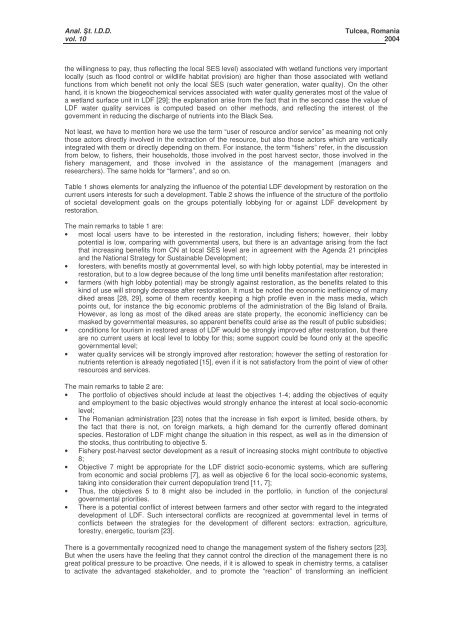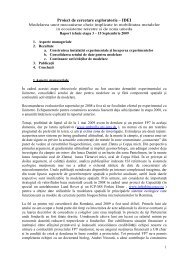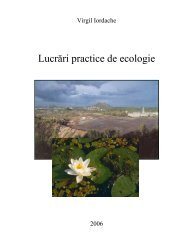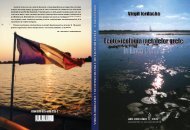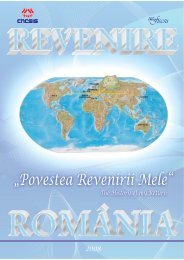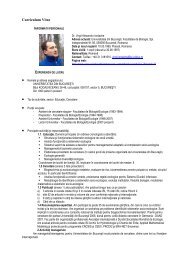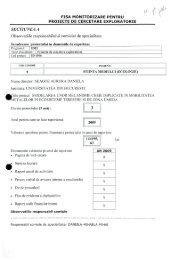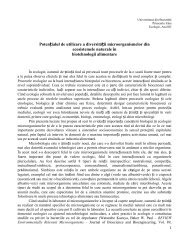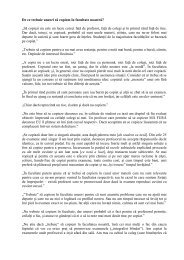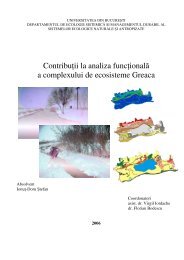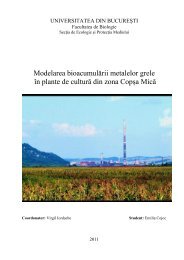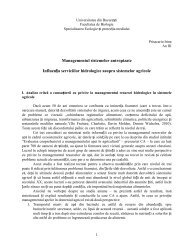PDFCreator, Job 14 - CESEC
PDFCreator, Job 14 - CESEC
PDFCreator, Job 14 - CESEC
- No tags were found...
You also want an ePaper? Increase the reach of your titles
YUMPU automatically turns print PDFs into web optimized ePapers that Google loves.
Anal. t. I.D.D.Tulcea, Romaniavol. 10 2004the willingness to pay, thus reflecting the local SES level) associated with wetland functions very importantlocally (such as flood control or wildlife habitat provision) are higher than those associated with wetlandfunctions from which benefit not only the local SES (such water generation, water quality). On the otherhand, it is known the biogeochemical services associated with water quality generates most of the value ofa wetland surface unit in LDF [29]; the explanation arise from the fact that in the second case the value ofLDF water quality services is computed based on other methods, and reflecting the interest of thegovernment in reducing the discharge of nutrients into the Black Sea.Not least, we have to mention here we use the term “user of resource and/or service” as meaning not onlythose actors directly involved in the extraction of the resource, but also those actors which are verticallyintegrated with them or directly depending on them. For instance, the term “fishers” refer, in the discussionfrom below, to fishers, their households, those involved in the post harvest sector, those involved in thefishery management, and those involved in the assistance of the management (managers andresearchers). The same holds for “farmers”, and so on.Table 1 shows elements for analyzing the influence of the potential LDF development by restoration on thecurrent users interests for such a development. Table 2 shows the influence of the structure of the portfolioof societal development goals on the groups potentially lobbying for or against LDF development byrestoration.The main remarks to table 1 are:• most local users have to be interested in the restoration, including fishers; however, their lobbypotential is low, comparing with governmental users, but there is an advantage arising from the factthat increasing benefits from CN at local SES level are in agreement with the Agenda 21 principlesand the National Strategy for Sustainable Development;• foresters, with benefits mostly at governmental level, so with high lobby potential, may be interested inrestoration, but to a low degree because of the long time until benefits manifestation after restoration;• farmers (with high lobby potential) may be strongly against restoration, as the benefits related to thiskind of use will strongly decrease after restoration. It must be noted the economic inefficiency of manydiked areas [28, 29], some of them recently keeping a high profile even in the mass media, whichpoints out, for instance the big economic problems of the administration of the Big Island of Braila.However, as long as most of the diked areas are state property, the economic inefficiency can bemasked by governmental measures, so apparent benefits could arise as the result of public subsidies;• conditions for tourism in restored areas of LDF would be strongly improved after restoration, but thereare no current users at local level to lobby for this; some support could be found only at the specificgovernmental level;• water quality services will be strongly improved after restoration; however the setting of restoration fornutrients retention is already negotiated [15], even if it is not satisfactory from the point of view of otherresources and services.The main remarks to table 2 are:• The portfolio of objectives should include at least the objectives 1-4; adding the objectives of equityand employment to the basic objectives would strongly enhance the interest at local socio-economiclevel;• The Romanian administration [23] notes that the increase in fish export is limited, beside others, bythe fact that there is not, on foreign markets, a high demand for the currently offered dominantspecies. Restoration of LDF might change the situation in this respect, as well as in the dimension ofthe stocks, thus contributing to objective 5.• Fishery post-harvest sector development as a result of increasing stocks might contribute to objective8;• Objective 7 might be appropriate for the LDF district socio-economic systems, which are sufferingfrom economic and social problems [7], as well as objective 6 for the local socio-economic systems,taking into consideration their current depopulation trend [11, 7];• Thus, the objectives 5 to 8 might also be included in the portfolio, in function of the conjecturalgovernmental priorities.• There is a potential conflict of interest between farmers and other sector with regard to the integrateddevelopment of LDF. Such intersectoral conflicts are recognized at governmental level in terms ofconflicts between the strategies for the development of different sectors: extraction, agriculture,forestry, energetic, tourism [23].There is a governmentally recognized need to change the management system of the fishery sectors [23].But when the users have the feeling that they cannot control the direction of the management there is nogreat political pressure to be proactive. One needs, if it is allowed to speak in chemistry terms, a cataliserto activate the advantaged stakeholder, and to promote the “reaction” of transforming an inefficient


